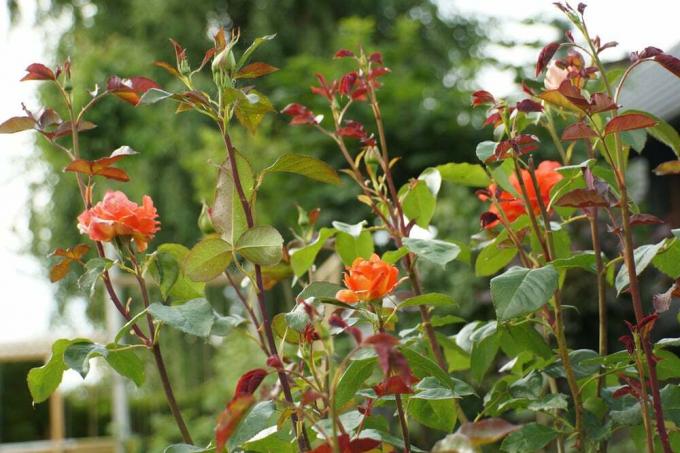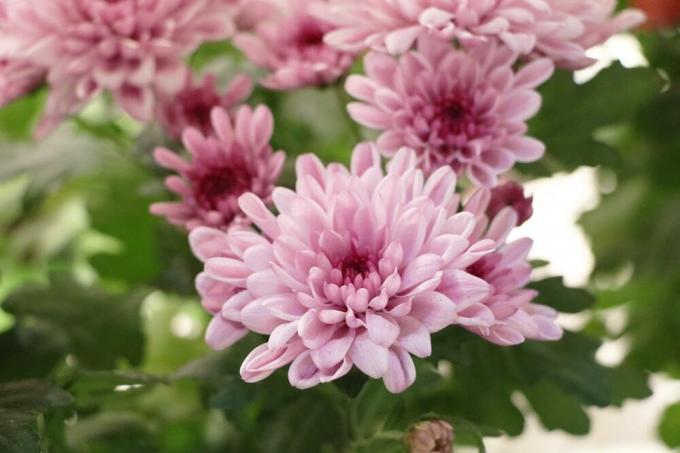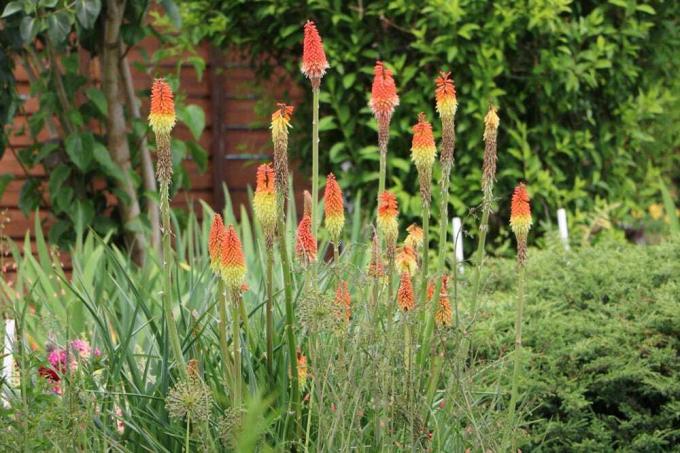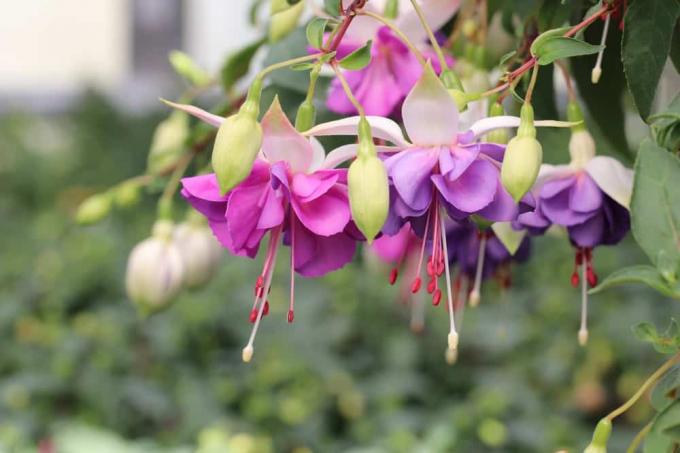

Table of contents
- Purpose of pruning – more important for pot roses than for garden roses
- Pruning potted roses properly: the basics
- Tool
- Right cutting time
- Potted rose pruning by variety
- Flower miracle among the pot roses
- Cut climbing roses in the tub
- Conclusion
Pot roses do best when you are careful to only feed the leaf mass at the top that matches the root size. This requires regular pruning, at the right time and a little differently depending on the rose variety:
Purpose of pruning – more important for pot roses than for garden roses
Plants grow, and plants that gardeners help grow are cultivated by man. So “taken into culture”, according to Wikipedia (de.wikipedia.org/wiki/Kultur) shaped by humans, with the result of a cultural achievement; before our eyes as a machine or a work of art, as a mental structure from composition and book to law. Some gardeners are not familiar with the fact that they are working in the very foundations of human culture: “The Culture" with the cultivation of plants, the root of the word culture is the Latin "cultura" = processing, care, Agriculture.
The tub roses cultivated on the terrace are also "designed" by us, which qualifies pruning by the gardener as an essential part of the plant culture. If a cultivated rose (as it is called in contrast to the wild rose) created by man through breeding does not have a If pruned, over time it will turn back into exactly that wild rose, a little bit every season more. What can look very nice in the garden, which is why the garden culture of a rose could well be limited to cutting back diseased plant matter.
Not an option for pot roses, they have to be pruned if they are not to compete with people for space on the balcony or terrace. But potted roses also have to be pruned so that they do well: A potted rose has to make do with a volume of soil that is sometimes dangerously limited compared to the garden location. A rose can only cope with this in the long run if the plant mass in the upper area is constantly adapted to the root development in the tub, so the rose never has to supply too much plant mass. In addition, the right pruning ensures that the rose takes on a pleasing shape that suits the tub, with many branched shoots that grow densely; with maximum vigor and resilience for healthy growth and lots of new blooms each season.
Pruning potted roses properly: the basics
This is how the correct pruning basically looks like:
- Potted roses are pruned in the spring when they are just beginning to sprout
- They are cut back all around as far as the current shape requires
- First, all diseased and dried branches are cut away
- Then all the shoots that grow across, crooked, too close to others
- If possible, always cut 5 mm above one eye
- Slightly inclined so that rainwater runs off the cut surface, otherwise it could rot
- Later in the year, in preparation for winter, all dried flowers and leaves are removed
- Otherwise they would absorb moisture, which dries very slowly – a feast for mushrooms
- Any rose that grows happily and excessively can be "trimmed" a bit just before hibernation
Depending on the type of rose, the cut is a little different in scope and detail, see below, now let's continue with the basics, the right tool:
Tool
A good pair of rose scissors can extend the life of a rose considerably, so a few thoughts about pruning tools are worthwhile:
- A good pruning shears has a bypass blade, where the blades slide past each other
- This blade shape, taken from the pruning shears, cuts, while the anvil blade rests on a surface and, in case of doubt, squeezes rather than cuts
- Squeezing causes ugly, fibrous longitudinal wounds that the rose can barely close
- The bypass scissors cannot squeeze, they only get stuck if a branch is too thick
- This doesn't happen with a pot rose, it could only develop such thick stems in pots the size of a house
- A prerequisite for work that does not damage the rose is a sharp blade, even with the bypass scissors
- Fuzzy scissors leave behind a "bark in fringes" that is great for germs and fungi to cling to
- But good bypass shears last a long time, they only have to be sharpened at large intervals, at considerably greater intervals than anvil shears
- Buy from the manufacturer who also offers grinding and repair services, e.g. B. at a German scissors manufacturer
- Scissor prices start at around €10 for him, and he spends more on the product than on advertising
Right cutting time
The fact that the tub rose is cut in the spring when it starts to sprout makes sense: when the rose is about to starts drifting, her metabolism works at full speed, she can close numerous cuts effortlessly. In addition, the tub rose comes through the winter better with full foliage, and if a branch tip suffers from frost, there is "enough material" to cut away in spring. Incidentally, this also applies to shrub roses, for which autumn pruning is often recommended. If you prune a little late in the fall, or if winter comes surprisingly earlier, the pruning would cause problems pull: The rose cannot close the cuts sufficiently, goes into the winter with open wounds and freezes to death more quickly. However, this recommendation is only justified in exceptional cases, if the shrub rose again over the course of the season has grown that it urgently needs to be thinned out in order to survive the winter without fungi and pests in the too dense foliage come. Incidentally, the right weather should also prevail when pruning: nice and dry and friendly, neither an extensive rain front nor the last late frost should be in front of the door.
Potted rose pruning by variety
A wide variety of roses can be planted in tubs, and a variety of roses are sold as tub roses. If a rose is in a pot, it always has to be cut back if you don't want to fill the balcony or terrace with soil at some point and leave it to your rampant rose. When cutting the individual types of roses, however, there are subtle differences, which are discussed below:
- The completely normal cultivated rose in tubs (the normal tub rose) is pruned back every spring
- A little more or a little less, depending on whether you want it to increase or not
- But all in all, the normal Hybrid Tea flowers on the shoots that develop after pruning
- In the case of grafted roses, the wild shoots that the rootstock may produce must also be removed
- So all the shoots above the grafting point, the rose species whose flowers you want to see only grows from there
- In the case of standard roses, all shoots that appear below the crown are removed during pruning
- Miniature roses should be pruned back quite heavily to stimulate growth
Flower miracle among the pot roses

As if there wasn't enough choice among "normal roses" - there are always new trends among potted roses too, and these currently include wild roses, shrubby roses and reblooming roses that want special treatment when pruning:
- Potted wild roses and shrub roses need quite a bit of pruning to keep them in pot-sized sizes
- Not only at the top, but when repotting, the root is always severely cut all around.
- But not from the beginning, they develop their flowers on the older branches, so they are first used to form a small framework
- After that, only about half of the shoots are cut back so as not to cut away the blossom with the previous year's wood
- The annual pruning can become a rejuvenation pruning by completely removing old shoots to correct the shape
- If the shrub grows too dense inside, it is thinned out to prevent fungal attack
- Shrub roses that flower several times (repeating) or that flower continuously and new varieties of Hybrid Tea roses that flower several times are cut back by a third in the spring
- Here you encourage the growth of more flowers in the same season if you cut away faded flowers at a time
Cut climbing roses in the tub
Climbing roses can also be kept in tubs, they also get a special treatment:
- First of all, it is a matter of growing a framework of strong branches by attaching suitable shoots to the trellis and cutting away the rest
- Every spring, all new side shoots are cut down to a few buds, immediately after flowering in the case of the one-flowering roses
- With climbing roses that are reblooming, you can always remove the withered flowers, then more new flowers will follow
- In the spring, these climbing roses get their topiary, which also cuts away any winter damage
- If a climbing rose grows too tall you can also prune at the very top, this rejuvenation will only encourage it to grow more vigorously
- Only cut the climbing roses in spring when no more night frosts are to be expected
Conclusion
Properly pruning roses in pots is anything but rocket science. However, if you want to get the maximum amount of flowers out of the potted roses, each rose has its own cut.
 garden editorial
garden editorial I write about everything that interests me in my garden.
Learn more about fall gardening

Autumn decoration & winter decoration for balcony and terrace
When the summer flowers on the balcony and terrace have faded, the dreary picture calls for autumn/winter planting and decoration. For working people with little time and desire to care for plants, there is an easy-care one Basic planting that goes with fall and winter (and spring/summer) decorations over and over again quickly works differently.

Plant and decorate the balcony and terrace in autumn
When the balcony/terrace looks barren and empty, autumn is a good time to finally plant and decorate it. When the summer flowers have faded, the dreary picture also calls for autumn planting. We show how you can create a beautiful fall balcony and patio full of fall blooms in a manageable amount of time, starting with the classic fall beauties.

Autumn flowers for the balcony and terrace - the most beautiful perennials
Perennials are best planted in autumn, perennials are perennials or perennial, perennials are extremely easy to care for, many perennials show their flowers until late autumn, perennials often bloom extraordinarily beautiful and/or distinctive - in an application for "best autumn flower" an autumn perennial would definitely win make. In the article you will be introduced to the not endlessly available autumn flowers, beautiful and distinctive perennials.

Autumn planting time: these plants must be planted in autumn
Autumn is a good planting time for many plants, and it is the best planting time for all plants that start developing very early in the spring. These plants will be presented to you in the article.

Flowering autumn perennials - these bloom into winter
Among the perennials are the plants with the most beautiful flowers, and many of the perennials show these flowers in the fall or well into the fall. Some autumn perennials Cultivated varieties of autumn perennials bloom even longer, in winter and beyond, you will learn about them in the article.

Decorate flower boxes for fall and winter
Decorate flower boxes for autumn and winter? Which decoration is possible depends a bit on whether the flower boxes, which are empty after the summer flowers have been disposed of, should be decorated quickly until they come back in spring planted, whether they should be planted with autumn flowers until next spring, or whether you are designing and decorating a longer-lasting autumn and winter planting would like. In the article you will receive suggestions for the quick and for the more complex variants.
